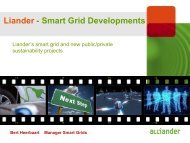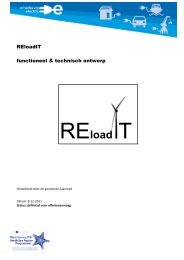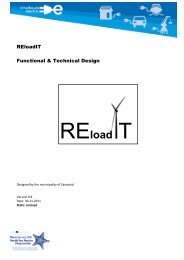renewable energy in zaanstad: from theory to practice - e-harbours
renewable energy in zaanstad: from theory to practice - e-harbours
renewable energy in zaanstad: from theory to practice - e-harbours
Create successful ePaper yourself
Turn your PDF publications into a flip-book with our unique Google optimized e-Paper software.
short term and have high short term fluctuations. As a consequence, their connection <strong>to</strong> the utility<br />
network can lead <strong>to</strong> grid <strong>in</strong>stability or even failure, if these systems are not properly designed or<br />
controlled [5]. Among others, important aspects <strong>to</strong> consider with the implementation of distributed<br />
generation <strong>in</strong><strong>to</strong> the distribution network are:<br />
- Protection (tripp<strong>in</strong>g, fault levels, bl<strong>in</strong>d<strong>in</strong>g of protection, etc.)<br />
- Voltage limits<br />
- Frequency<br />
- Flicker<br />
- Harmonic dis<strong>to</strong>rtion<br />
The impact of the implementation on the distribution grid has different effects for PV cells compared<br />
<strong>to</strong> w<strong>in</strong>d turb<strong>in</strong>es. PV cells are connected on the low voltage network; w<strong>in</strong>d turb<strong>in</strong>es are usually<br />
connected <strong>to</strong> the MV or sometimes even HV network. The <strong>in</strong>jection of power <strong>from</strong> w<strong>in</strong>d turb<strong>in</strong>es and<br />
PV cells affects both the voltage quality. Because the voltage level should be with<strong>in</strong> limits at all times,<br />
this is an important requirement and should be considered when plans are made for the<br />
implementation of large quantities of solar and w<strong>in</strong>d <strong>energy</strong> on the distribution network.<br />
Although the current grids have evolved over more than a hundred year and have been perform<strong>in</strong>g<br />
well, the implementation of large quantities of distribution generation on the distribution network<br />
can cause problems <strong>in</strong> terms of reliability and power quality. A lot of research has been go<strong>in</strong>g on <strong>in</strong><br />
the field of au<strong>to</strong>mation of the current grid by communication and <strong>in</strong>formation technologies. A<br />
common term used <strong>in</strong> this field of research is ‘Smart Grid’. Smart Grid however is a very broad term<br />
and used <strong>in</strong> different contexts and different def<strong>in</strong>itions. This is why it is important <strong>to</strong> def<strong>in</strong>e Smart<br />
Grid and review the different concepts of Smart Grids. In the next section the def<strong>in</strong>ition, concepts<br />
and capabilities of Smart Grid will be reviewed.<br />
4.3 DEFINITION OF SMART GRIDS<br />
The term Smart Grid has a lot of different def<strong>in</strong>itions <strong>in</strong> the literature. Below are some examples<br />
given.<br />
‘A Smart Grid is an electricity network that can <strong>in</strong>telligently <strong>in</strong>tegrate the actions of all users<br />
connected <strong>to</strong> it - genera<strong>to</strong>rs, consumers and those that do both – <strong>in</strong> order <strong>to</strong> efficiently deliver<br />
susta<strong>in</strong>able, economic and secure electricity supplies.’ (The European Technology Platform Smart<br />
Grids)<br />
‘A smart grid is the electricity delivery system (<strong>from</strong> po<strong>in</strong>t of generation <strong>to</strong> po<strong>in</strong>t of consumption)<br />
<strong>in</strong>tegrated with communications and <strong>in</strong>formation technology for enhanced grid operations, cus<strong>to</strong>mer<br />
services, and environmental benefits. (US Department of Energy)<br />
Although a lot of different def<strong>in</strong>itions can be found <strong>in</strong> the literature, there are some basic similarities.<br />
Integrat<strong>in</strong>g the key themes, a Smart Grid can be def<strong>in</strong>ed as the <strong>in</strong>tegration of ICT <strong>to</strong> the current<br />
electric grid <strong>to</strong> enhance the susta<strong>in</strong>ability, economic efficiency and security of electricity supply. A<br />
Smart Grid is not really a new technology; it is rather a new comb<strong>in</strong>ation of different exist<strong>in</strong>g<br />
20









